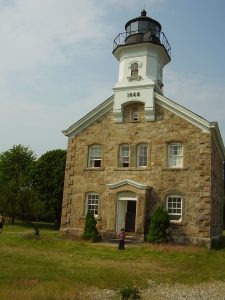By Emily Clark
In the outer reaches of Norwalk Harbor, more than a dozen islands lay scattered among the reefs and mudbanks of northern Long Island Sound. While most are privately owned or used for birdwatching or camping, the second largest, Sheffield Island, is home to one of Connecticut’s historic lighthouses—a stone structure with a celebrated past dating back two hundred years.
Marking Norwalk Harbor
As an important oyster farming center in the 19th century, Norwalk has long been a city rich in maritime tradition. Over its history, Sheffield Island has had many names, including Little Longe, White’s Island, and Smith’s Island, among many others. According to town records, in the late 1600s, “Winnipank, Indian Sagamour of Norwalk” occupied the island, followed by Norwalk’s first minister, Thomas Hanford. After subsequent owners and a stint as community land, a Revolutionary War captain named Robert Sheffield eventually bought the island in the early 19th century, giving it its current name.
Despite the harbor’s treacherous, rugged ledges, it didn’t have a lighthouse until the 19th century. In 1826, the 52-acre island caught the interest of the US Treasury Department, which at the time oversaw the country’s lighthouses. Officials were scouting sites in the Norwalk Islands for an appropriate location to build a lighthouse and settled on the western end of Sheffield Island. The following year, the first lighthouse opened—beginning a long tradition of standing guard and guiding sailors as well as witnessing steamship fires, Prohibition rum runners, and wayward livestock.
The Lighthouse’s Colorful History
Gershom Smith, Robert Sheffield’s son-in-law, became the lighthouse’s first keeper. He lived on the island in a separate stone dwelling with his wife and 12 children. In addition to manning the light for almost 20 years, Smith also farmed, harvested oysters, and raised animals. Frequently at low tide, the family’s cows wandered among the Norwalk Islands, prompting Smith to row from place to place to ensure each one was milked.
During Smith’s tenure as lightkeeper, the island’s residents witnessed one of the worst marine disasters in history. In January 1840, when the steamship Lexington cruised toward the Sheffield Island lighthouse, gusts of wind blew cotton bales that the ship was transporting near its smokestack, causing a fire to erupt onboard. The fire killed a majority of the 150 passengers.
Gershom Smith manned the lighthouse until his death in 1845 when Lewis Whitlock became keeper and worked on the island through the advent of the Civil War. Sailors often complained that the light on Sheffield Island was not tall or strong enough to be seen. With shipping traffic around Norwalk increasing after the war, Congress allocated funds for a new lighthouse to be built. This structure—a Victorian-style lighthouse completed in 1868—included a cast-iron lantern tower and a composite compact Fresnel lens. Such improvements allowed for both increased maritime safety as well as stunning views. An 1869 news story from the Norwalk Gazette commented that “the view from the top of the Sheffield Lighthouse, on a clear summer’s day, is worth a journey of a thousand miles to see.”
More Than Just a Lighthouse
Though the lighthouse ended its navigational service in early 1902 (replaced by the nearby Green Ledge Light), the island and its buildings continued to serve a purpose, albeit sometimes illegal purpose. Thanks to the island’s privacy and relative remoteness, wealthy business men making questionable deals and Prohibition-era rum runners used it for illicit activity. It also became a haven for mothers and children throughout the years of the cholera epidemic that hit New York City. Additionally, destruction caused by the power of New England storms forced a country club on the island to close in 1937.
The 1980s brought renewed interest in preserving the 1868 Sheffield Island lighthouse and keeper’s cottage. The Norwalk Seaport Association acquired both buildings from the Stabell family who had owned the property since 1914. These structures, refurbished by volunteers, entered the National Register of Historic Places in 1989.
Available via ferry service, thousands of people visit Sheffield Island and its lighthouse every year. The Norwalk Seaport Association installed a solar-powered, non-navigational light in 2011, prompting Association President Tom Shrum to say, “The tower light…will be a welcoming beacon to our visitors and a reminder of the history and significance of the lighthouse.”
Emily Clark is a freelance writer and an English and Journalism teacher at Amity Regional High School in Woodbridge.










